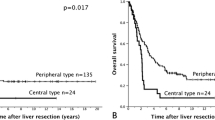Abstract
Introduction: Surgical resection is presently the only approach that offers patients with liver metastases from colorectal carcinoma substantial chance of cure. This article summarizes the current literature as well as the author’s personal experience. Background and discussion: Since 1980, 5-year survival figures have ranged from 21% in collected series to 48% in single-institution series. The 30-day mortality of elective liver resection in non-cirrhotic patients ranges now between 0% and 5%. The overwhelming indicator of prognosis is the completeness of tumor removal according to the R-classification. The specific impact of all other factors should therefore be analyzed by excluding non-radical procedures and operative mortality. Among patient characteristics, age and gender do not significantly affect outcome, while the Karnofski stage is important. Regarding the primary tumor, the effect of staging and location is predominantly apparent in patients with synchronous metastases. Timing of metastasis detection is of some importance, as most authors found a slightly better outcome for metachronously detected metastases. With respect to the liver involvement, multiplicity of metastases and bilateral disease both seem to be of minor importance after R0-resection, while satellite lesions are significant in many series. The actual number of metastases is of minor effect, with a slight superiority in 5-year survival for patients with one to three nodules relative to patients with four nodules or more in most series, but identical results in the author’s own experience. The maximum diameter as an indicator of tumor burden represents a significant prognosticator in half of the reports analyzed. Extrahepatic disease reduces 5-year survival, but direct tumor invasion to adjacent structures, local recurrent disease, or one or few pulmonary metastases are no contraindication to liver resection as long as a R0-situation can be achieved. In contrast, lymph-node metastases at the liver hilum predict a poor outcome. They are likely to prove as a clear contraindication. With respect to the operative approach, a clear margin of 1 cm or more should be aimed at but, if the size or location of metastases do not allow a 1-cm margin, resection should still be performed, making every surgical effort to ensure a complete rim of unaffected tissue. Anatomic resections reduce the incidence of non-radical procedures and may improve survival. Whether there is an independent effect of operative blood loss, need for blood transfusion, and intraoperative hypotension on prognosis is still unclear. Adjuvant chemotherapy or radiotherapy after R0-resection is unlikely to improve results. There are also no convincing data available demonstrating a prognostic benefit when a non-curative resection is supplemented by any medical treatment. In patients with recurrent disease, a re-resection is possible in roughly 20%. Survival from the time of re-intervention ranges from 21% to 57% after 5 years and, thus, justifies a close follow-up policy after R0-resection of the initial liver metastases. Conclusion: The previous ”clear” contraindications to liver resection have become less important. Future efforts may be directed to more accurate patient selection and new approaches of neoadjuvant and adjuvant therapeutic strategies.
Similar content being viewed by others
Author information
Authors and Affiliations
Additional information
Received: 22 June 1999 Accepted: 28 June 1999
Rights and permissions
About this article
Cite this article
Scheele, J., Altendorf-Hofmann, A. Resection of colorectal liver metastases. Langenbeck's Arch Surg 384, 313–327 (1999). https://doi.org/10.1007/s004230050209
Issue Date:
DOI: https://doi.org/10.1007/s004230050209




